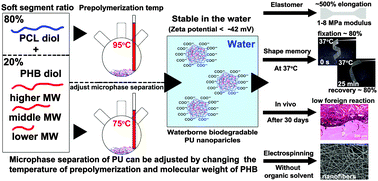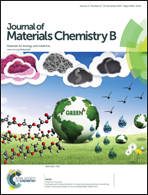Synthesis and characterization of waterborne polyurethane containing poly(3-hydroxybutyrate) as new biodegradable elastomers†
Abstract
Poly(3-hydroxybutyrate) (PHB) is a biodegradable polymer with good biocompatibility. The crystalline and brittle nature has limited its processing for further applications. In this study, PHB diols were employed as a part of the soft segment to synthesize waterborne polyurethane (PU). Poly(ε-caprolactone) (PCL) diol was used as the major soft segment (80 mol%) and blended with PHB diol (20 mol%) at the beginning of the synthesis. PHB diols with three different molecular weights (1352, 1679, and 2062 g mol−1) were respectively used. The microphase separation was adjusted by changing the prepolymerization temperature. Physico-chemical characterization revealed that the PCL–PHB-based PUs had 3–7% crystallinity, good flexibility (∼1–8 MPa modulus and ∼500% elongation), and some shape memory behavior (up to ∼80% shape recovery). The use of higher molecular weight PHB diol (2062 g mol−1) and a prepolymerization temperature at 95 °C gave rise to PU with the best properties in general. The latter PU also showed excellent biodegradation (52% weight loss after 30 days) and biocompatibility (capsule thickness ∼23 μm) in vivo. Furthermore, the PU dispersion could be electrospun into nanofibers (∼400 nm diameter) without the use of organic solvents. Therefore, the eco-friendly PU containing PHB blocks has good mechanical properties, processing abilities, and biocompatibility, and may be a new category of biodegradable elastomers and potential biomaterials for cardiovascular and other medical applications.

- This article is part of the themed collection: 2015 Journal of Materials Chemistry B Hot Papers

 Please wait while we load your content...
Please wait while we load your content...